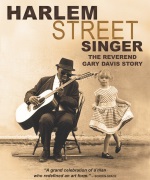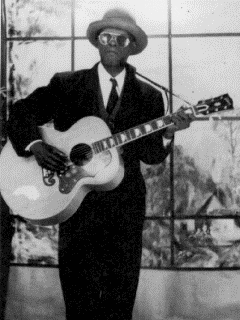





Folk on the Silver Screen: Acoustic Traditions Films is proud to present Harlem Street Singer the first-ever film to tell the little-known story of Reverend Gary Davis the great ragtime and gospel musician. Tracing his journey from the tobacco warehouses of the rural south to the streets of Harlem, the film is a revealing portrait of an artist who impacted the musical landscape of folk music and endeared himself to musicians such as Pete Seeger, Bob Weir, Jerry Garcia, Jorma Kaukonen, David Bromberg, Bob Dylan and countless others. Harlem Street Singer celebrates the beauty and spirituality of his music as well as the human qualities that made Reverend Davis a much beloved teacher and minister.
Reverend Gary Davis, also Blind Gary Davis, (April 30, 1896 – May 5, 1972) was a blind African American blues and gospel singer and guitarist, who was also proficient on the banjo guitar and harmonica. His finger-picking guitar style influenced many other artists and his students include Stefan Grossman, David Bromberg, Roy Book Binder, Larry Johnson, Nick Katzman, Dave Van Ronk, Rory Block, Ernie Hawkins, Larry Campbell, Bob Weir, Woody Mann, and Tom Winslow.
He has influenced Bob Dylan, The Grateful Dead, Wizz Jones, Jorma Kaukonen, Keb' Mo', Ollabelle, Resurrection Band, and John Sebastian of The Lovin' Spoonful.

Gary Davis was born in the Piedmont region of the country, in Laurens, South Carolina, and was the only one of eight children his mother bore who survived to adulthood. He became blind as an infant. Davis reported that his father was killed in Birmingham, Alabama, when Davis was ten, and Davis later said that he had been told that his father had been shot by the Birmingham High Sheriff. He recalled being poorly treated by his mother and that before his death his father had given him into the care of his paternal grandmother.
He took to the guitar and assumed a unique multi-voice style produced solely with his thumb and index finger, playing not only gospel, ragtime and blues tunes, but also traditional and original tunes in four-part harmony.
In the mid-1920s, Davis migrated to Durham, North Carolina, a major center for black culture at the time. There he taught Blind Boy Fuller and collaborated with a number of other artists in the Piedmont blues scene including Bull City Red. In 1935, J. B. Long, a store manager with a reputation for supporting local artists, introduced Davis, Fuller and Red to the American Record Company. The subsequent recording sessions marked the real beginning of Davis' career and are available in his Complete Early Recordings. During his time in Durham, Davis converted to Christianity; in 1937, he would be ordained as a Baptist minister. Following his conversion and especially his ordination, Davis began to express a preference for inspirational gospel music.
In the 1940s, the blues scene in Durham began to decline and Davis migrated to New York. In 1951, several years before his "rediscovery", Davis's oral history was recorded by Elizabeth Lyttleton Harold (the wife of Alan Lomax) who transcribed their conversations into a 300+-page typescript.
The folk revival of the 1960s re-invigorated Davis' career and included a performance at the Newport Folk Festival and having Peter, Paul and Mary record his version of "Samson and Delilah", also known as "If I Had My Way" which is originally a Blind Willie Johnson song that Davis had popularized. "Samson and Delilah" was also covered and credited to Davis on the Grateful Dead's "Terrapin Station" album. Eric Von Schmidt credits Rev. Davis with three-quarters of Schmidt's Baby, Let Me Follow You Down which Bob Dylan covered on his debut album for Columbia. Blues Hall of Fame singer and harmonica player Darrell Mansfield has also recorded several of Rev. Davis' songs.
Davis died in May 1972, from a heart attack in Hammonton, New Jersey. He is buried in plot 68 of Rockville Cemetery in Lynbrook, Long Island, New York.

Text is available under the Creative Commons Attribution-ShareAlike License.
Date: June 2015.
Photo Credits:
(1) Reverend Gary Davis,
(2)-(4) CD/DVD Cover (unknown/website).